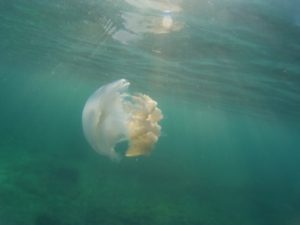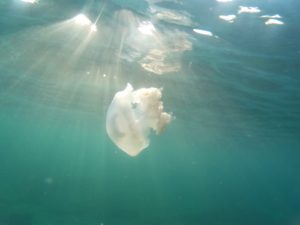Several specimens of giant jellyfish have been seen off the coast of Mallorca. It is the species ‘Rhizostoma Luteum’, “a very rare and little known jellyfish“, explains the general director of Fishing and the Marine Environment, Antoni Grau. According to the expert, “it was described in 1837 in the Strait of Gibraltar but then decades passed without anyone seeing one again”.
This summer there have been many bathers who have warned of the presence of this giant jellyfish in Mallorca, which can weigh up to 40 kilos. “As it resembles the ‘Rhizostoma pulmo’, it was believed that the species did not exist,” says Grau. However, “as of 2013 the observations have become more common“.
The one in the picture was seen in the bay of Palma, specifically in the Bellavista area, next to Cala Blava. Due to their size, they are easy to detect, however the shock when finding it is considerable due to its large size.
According to Antoni Grau, “this year they have appeared on the Mediterranean coasts of southern Spain and have caused attention, but it is not clear if they come here swimming as adults or as juvenile. What seems clear that its dispersal path is the Atlantic current that irrigates the south and east of the Balearic Islands”.
Rhizostoma Luteum: Is it dangerous?
The expert is clear when answering about the danger of this giant jellyfish seen in Mallorca. “It is hardly stinging, nothing to do with ‘Pelagia noctiluca’ and, much less, with ‘Physalia'”. The first is the most common in the waters of the islands, small and purple. While the second refers to the famous Portuguese caravel, one of the most dangerous in Mediterranean waters.
Luckily, these giant ‘Rhizostoma Luteum’ jellyfish do not pose a danger to bathers, despite the scare they can cause. Grau assures that, before their sighting, it is advisable to “leave them in peace, without hitting or mistreating them. They are not dangerous at all, despite their size“.

‘Rhizostoma Luteum’ in Mallorca. Photos: Mallorca Global.









Leave A Comment